Renault Kangoo Review 2025
Renault Kangoo At A Glance
Introduced in 2022, the most recent version of the Renault Kangoo has brought the French manufacturer’s offering bang up-to-date with more load space than its predecessor and a fresh, modern cabin, not to mention excellent driving characteristics. Read our Renault Kangoo review to find out why it’s now up there at the top of the class.
Sold as a rival to the likes of the Citroen Berlingo, Peugeot Partner, and Ford Transit Connect, the latest generation Kangoo has made major steps forward in terms of its styling, with bold C-shaped headlights and a much lower ride height than previous variants of the French manufacturer’s small van.
It also has a much smarter and far more technologically advanced cabin, with a car like feel and comfortable seats, as well as a vastly improved driving position.
There are some compromises, though. On the continent, the Kangoo is offered with a load-through bulkhead as well as a very clever design that removes the B-pillar to increase the width of the side-loading door, but this was never engineered for right-hand-drive as Renault didn’t consider the cost in line with the sale opportunity – if you’re looking for that level of functionality then you’d be better off considering one of the Stellantis Group vans such as the Vauxhall Combo, Citroen Berlingo or Peugeot Partner, which at least offer a longer load option.
If that’s not of paramount importance, then the Renault Kangoo remains an interesting option. Alongside the electric Renault Kangoo e-Tech, reviewed separately, the mainstays of the Kangoo range will be the two 1.5-litre diesel models, with a choice of 95PS or 115PS. The less powerful model is offered with a six-speed manual gearbox while the punchier unit is only offered with a seven-speed automatic.
There’s also a 100PS 1.3-litre petrol engine for those who don’t want a diesel model, equipped with a six-speed gearbox.
Two trims are on offer – Advance and Extra - and it’s a good, solid offering in the small van market that’s well worth a look.
Driving the Renault Kangoo
There are three engines on offer in the Renault Kangoo.
The cheapest of these is the 1.3 TCe 100 turbocharged petrol unit, which has 100PS and a quoted fuel economy figure of 41.5mpg. It’s better with lighter loads on board but certainly doesn’t feel out of its depth, meaning it’s ideal for courier work and light deliveries.
Otherwise, there are two Blue dCi diesels with 95 or 115PS, the latter of which is only offered with a seven-speed automatic transmission. Both perform eagerly, with the manual 95PS model delivering 53.3mpg and the 115PS auto returning 50.4mpg.
Both diesel models feel quite sprightly, while the handling is superb for a van – indeed, the Renault Kangoo is one of the most enjoyable vans you can drive, the only downside being a slightly firm ride when unladen and a marginally wider turning circle than the model’s key rivals from Stellantis and Ford, which hardly makes a difference in the real world.
Refinement is good with road noise well-supressed, visibility is good and there’s a wide range of safety and driver assistance systems on offer, though many of these are only available if you add-in the optional Technology Pack which adds around £1,300 to the price.
Other useful options are a rough road pack at £300 which raises the ride height and adds underbody protection and a choice of glazing packs to improve rearward visibility.
Renault Kangoo interior
The Renault Kangoo is offered in two lengths of 4.5 and 4.9 metres (with 3.3 or 4.2 cubic metres of load volume respectively), known respectively as ML and LL. A shorter SL model is offered in some markets but not the UK.
Both models have asymmetrical twin rear doors with a 60:40 split, while the LL has two side loading doors. The shorter ML just has a sliding door on the nearside. A crew cab version of the longer van is also on offer.
One of the Renault Kangoo’s stand-out features is its upper rack, a £300 option that allows users to safely maximise the use of space on offer. It’s essentially a racking area that’s underslung to the upper roof panel, allowing you to put narrow items such as ladders or sheets of wood, board or metal poles high up in the van, keeping the lower load space clear for bulkier and heavier items. Payload is class competitive – fractionally less than the Stellantis vans but negligibly so at 987kg for the LL (which has a heavy duty rear axle) and 850kg for the ML model.
The ML model offers a useful 1806mm of load length while the longer LL has 2230mm to offer, with a maximum load width of 1570mm and 1248mm between the wheelarches on both versions. The maximum loading height, meanwhile, is 1115mm through the door aperture and 1215mm in total.
We also like the fact that Advance versions of the Renault Kangoo come with black plastic bumpers front and rear – they manage to look quite smart and not basic at all, but also keep repair costs low if you do end up talking a parking knock.
Upfront, the cabin is car-like in its layout and both trim levels feature an eight-inch touchscreen, DAB and smartphone integration. The plusher Extra model gets a double passenger seat and Renault’s ‘Flex’ wheels, which look like alloys but aren’t. There are some hard plastics on display, though, and the feeling is one of functionality rather than luxury.
Many of the switches and controls along with the steering wheel are shared with the Renault Clio.
Storage is good with an overhead shelf, a dash-top tray, a deep glovebox and an additional storage cubby above the instrument panel.


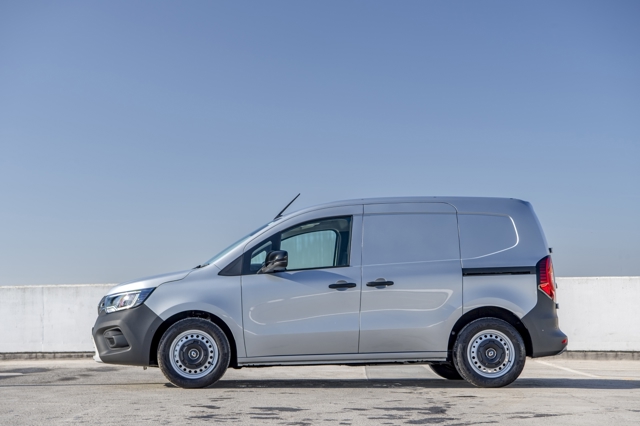

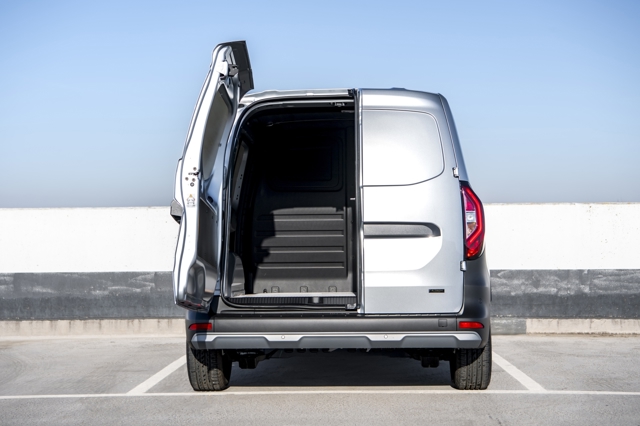
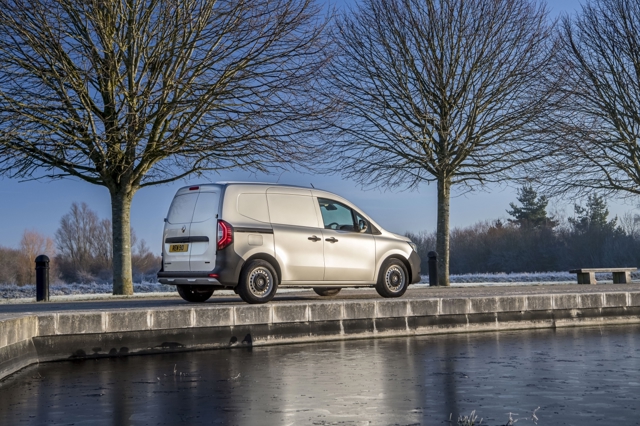
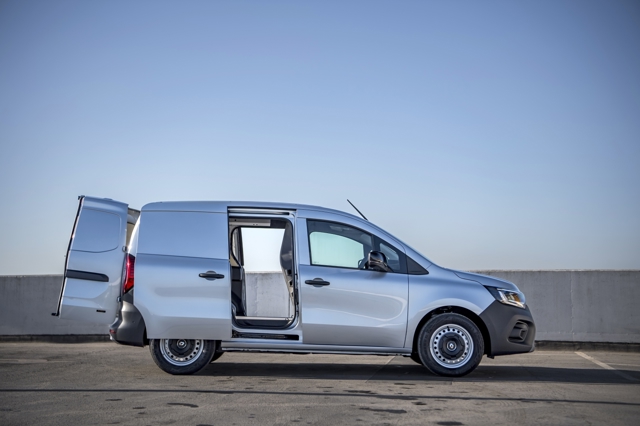
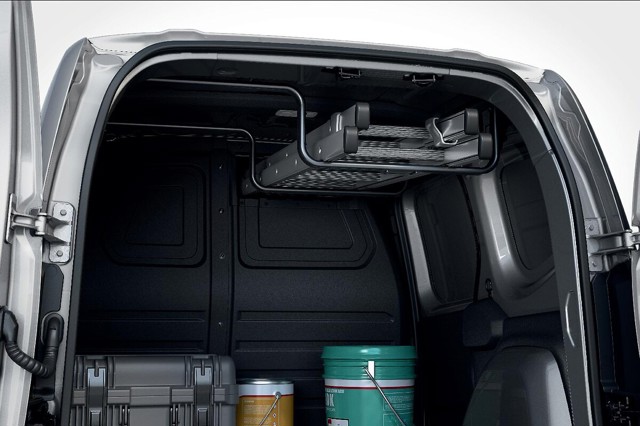
![2025 Renault Kangoo ML19 90kW 44kWh Advance [Safety] Van Auto](https://img.common.prod.group-mobility-trader.com/unsafe/trim/150x100/smart/filters:quality(70):no_upscale():format(webp)/https://cdn.uk.prod.group-mobility-trader.com/images/cas/2ebbf5ac690e0688c164d9ca60d3cdf8/679dd858a97cf9cb75524cefcbedc23c.jpg)
 Upper load rack, safety equipment, car-like cabin, petrol option
Upper load rack, safety equipment, car-like cabin, petrol option
 No load-through bulkhead, expensive options
No load-through bulkhead, expensive options
:no_upscale():format(webp)/https://cdn.uk.prod.group-mobility-trader.com/images/cas/25cde5ba59f06b8041b6c049f6b5c7bf/fbf18a0a8b3db412c0eb594fcc685c20.jpg)
:no_upscale():format(webp)/https://cdn.uk.prod.group-mobility-trader.com/images/cas/0b98182a17ebf89e83557802e3dbc0ce/18c7c8ea5952d0cf545ae18f6b8c4699.jpg)
:no_upscale():format(webp)/https://cdn.uk.prod.group-mobility-trader.com/images/cas/238d68df5f9414f83768ad1968420654/15d0d59cb5083884aeff6e75e8e13979.jpg)